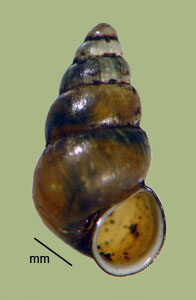> Habitat & Distribution
Pomatiopsis lapidaria ranges broadly through the interior drainages of the United States east of the Rockies, just reaching Canada in southern Ontario (Wu et al. 1997, Stewart 2006, Clarke 1981). We have approximately 25 records scattered about drainages of the Ohio and approximately 30 scattered around the Tennessee/Cumberland, from eastern Illinois to SW Virginia, from central Ohio to North Alabama.
From Atlantic drainages, Hubricht (1960) listed three NC records of P. lapidaria, one record in South Carolina, and two in Georgia. There are also several published reports in the vicinity of Washington, DC (DeWitt 1952, Beetle 1973, Steury 2014). The ANSP and DMNH hold several modern lots of Pomatiopsis from Delaware and New Jersey.
Populations typically reach maximum abundances on moist soil well above the water level. In fact, the snails stray up dry hillsides to such considerable distances from any permanent water source that they are more commonly collected by land snail researchers than by those of us focused on fresh waters. Hubricht (1960) reported that P. lapidaria populations of southern Atlantic drainages inhabit the coastal plain "only in swamps with uneven ground in which there were numerous small hummocks of dry land to which they could retreat during the wet season." We feel certain that P. lapidaria populations are not uncommon in our study area, but that we have undersampled them by our (unapologetically aquatic) survey techniques. FWGNA incidence unranked.
> Ecology & Life History
Sexes are separate in the Pomatiopsidae, females maturing at a larger size than males and perhaps comprising a greater proportion of the population (van der Schalie & Getz 1962). Eggs are laid singly in firm mud or soil (van der Schalie & Walter 1957).
Cultured in clay pots of moist soil, P. lapidaria requires about 12 months to mature, with a maximum life span of about 24 months (Davis 1967). The experiments of van der Schalie and Getz (1963) demonstrated that P. lapidaria can survive several days of desiccation at 25 degrees and 30% relative humidity, and that they drown after several days of total immersion.
North American Pomatiopsis is biologically similar to Oncomelania, the host of schistosomiasis in the Orient (Abbott 1948), and hybridization has been reported in the laboratory (van der Schalie et al 1962).
> Taxonomy & Systematics
The genus Pomatiopsis was placed in the family Hydrobiidae until split, together with seven other genera from four other continents, into a separate family Pomatiopsidae by Davis (1979). This judgement was confirmed by the sequencing results of Wilke and colleagues (2001, 2013).
The species-level taxonomy of the North American taxa seems to have remained stable for quite a few years. Pomatiopsis hinkleyi (Pilsbry 1896) and P. praelonga (Brooks & MacMillan 1940) are junior synonyms of P. lapidaria (Hubricht 1960).
> Maps and Supplementary Resources
- Pomatiopsis distribution in the Atlantic drainages (2023)
- Pomatiopsis in the drainage of The Ohio (2019)
- Pomatiopsis in the Tennessee/Cumberland (2022)
> References
Abbott, R. (1948)
Handbook of medically important mollusks in the Orient and the western
Pacific. Bulletin of the Museum of Comparative Zoology, Harvard,
100:269-328.
Beetle, D. (1973)
A checklist of the land and freshwater mollusks of Virginia. Sterkiana
49: 21-35.
Bickel, D. (1968)
Checklist of the mollusca of Tennessee. Sterkiana
31: 15 - 39.
Clarke, A.H. (1981)
The Freshwater Mollusks of Canada. National Museums of Canada, Ottawa,
Ontario, Canada.
Davis, G. (1967)
The systematic relationship of Pomatiopsis
lapidaria and
Oncomelania hupensis formosana (Prosobranchia:
Hydrobiidae). Malacologia, 6:1-143.
Davis, G. (1979)
The
origin and evolution of the gastropod family Pomatiopsidae, with
emphasis on the Mekong River Triculinae. Academy of Natural Sciences of
Philadelphia Monographs, 20: 1-120.
DeWitt, W. B. (1952)
Pomatiopsis lapidaria,
its occurrence in the Washington, D.C., area and its laboratory rearing
in comparison to that of Oncomelania
spp. J. Parasit. 38: 321-326.
Dillon, R.T., Jr. (2000)
The Ecology of Freshwater Molluscs. Cambridge University Press,
Cambridge, United Kingdom.
Hubricht, L. (1960)
Pomatiopsis lapidaria
on the southern Atlantic coastal plain, with remarks on the status of P. praelonga and P. hinkleyi.
Nautilus, 74:33-34.
Jokinen, E.H. (1992)
The
freshwater snails of New York State. New York State Museum Biological
Survey, New York State Museum Bulletin 482.
Steury, B.
(2014)
Aquatic snails (Gastropoda) from National Park sites in Northern
Virginia and adjacent Maryland, with an updated checklist of regional
species. Banisteria 44: 13 18.
Stewart, T. (2006) The
freshwater gastropods of Iowa (1821-1998): Species composition,
geographic distributions, and conservation concerns. Amer. Malac.
Bull., 21:59 - 75.
Stewart, T. W., &
R. T. Dillon, Jr. (2004)
Species composition and geographic distribution of Virginia's
freshwater gastropod fauna: A review using historical
records.
Am. Malac. Bull. 19: 79-91.
van der Schalie, H.
& Getz, L. (1962)
Distribution and natural history of the snail Pomatiopsis
cincinnatiensis (Lea). Am. Midl. Nat., 68:203-231.
van der Schalie, H. & Getz, L. (1963) Comparison
of temperature and moisture responses of the snail genera Pomatiopsis and Oncomelania.
Ecology 44: 73-831.
van der Schalie, H.,
Getz, J. & Dazo, B. (1962) Hybrids between
American Pomatiopsis
and oriental Oncomelania
snails. Am. J. Trop. Med. Hyg.,
11:418-420.
van der Schalie, H.
& Walter, H. (1957) The egg-laying habits of Pomatiopsis cincinnatiensis
(Lea). Transactions of the American Microscopical Society,
76:404-422.
Wilke, T., Davis, G.,
Falniowski, A., Giusti, F., Bodon, M. & Szarowska, M. (2001)
Molecular systematics of Hydrobiidae (Mollusca: Gastropoda:
Rissooidea): testing monophyly and phylogenetic relationships.
Proceedings of the Academy of Natural Sciences of Philadelphia,
151:1-21.
Wilke T., Haase M.,
Hershler R., Liu H-P., Misof B., Ponder W. (2013)
Pushing short DNA fragments to the limit: Phylogenetic relationships of
hydrobioid gastropods (Caenogastropoda: Rissooidea).
Molecular
Phylogenetics and Evolution 66: 715 736.
Wojdak, J.M. &
G.G. Mittelbach (2007)
Consequences of niche overlap for ecosystem functioning: an
experimental test with pond grazers. Zool. Univ. Mich., 417:
1-21.
Wu, S.-K., Oesch, R.
& Gordon, M. (1997) Missouri Aquatic Snails.
Missouri Department of Conservation, Jefferson City.








